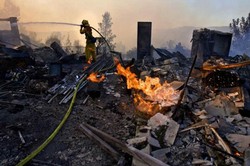In an earlier article I spoke about the flooding that had beset the Somerset Levels, which are still flooded several days later, but to think that they are the only area affected would be seriously wrong. Britain is at the end of a series of Atlantic storms that have seen record sized waves pounding southern shores: forty five foot storm waves were seen a mile off Cornwall, and in the harbour at Porthleven, Cornwall a storm wave was seen to be higher than the local church. There has been storm damage in some areas, and the main railway line from London to Cornwall has been washed away over a 250 foot stretch. Changes have to be made in the way in which the country is managed.

Flooding in Britain; what needs to be done
by frankbeswick
The floods that have hit Britain and Ireland have prompted some serious rethinking of ecological strategy.
The Answer Lies in the Soil
British readers of a certain age might just remember a radio personality called Ralph Whiteman who used to argue that the answer lies in the soil. It became something of a national joke, being taken up in a comedy programme, Beyond Our Ken, one of whose characters used it as catch phrase. But to some extent this is true. When we see rivers silting up and overflowing, and see them running reddish brown in flood water, it is farmers' soil that is being washed down. Thus we are losing soil at the same time as being flooded.
To some extent this is inevitable, but if the soil is being lost then it is a good idea to put it back. Thus dredging the rivers would be a double advantage. The river is deepened and the soil is returned to the land.
But there is more to the issue than this simple solution. There has been exacerbated loss in several areas. Some of this soil loss is due to the cutting down of hedgerows and the loss of tree cover in certain areas. American readers might have an image of Britain as a place full of charming fields surrounded by hedges that have been there for centuries, and to a great extent they would be correct in thinking this, but some farmers grubbed up hedges to expand the area of land for growing crops. But there were consequences! The hedges maintained the soil in the fields. as the roots served to bind soil together, and they impeded wind erosion that is always a problem in a windy island such as ours. As soil holds water, thinning soil holds less water than it used to before it thinned. Therefore we get quicker run off.A key element of the solution is: restore hedges and deepen soil across the land! Soil can be deepened by adding organic material, such as manure, compost and leaf mould to it, rather than exclusively relying on fertiliser.
Yet some of the problem is exacerbated by the fact that in some areas farmers have switched from grass to the very profitable maize. While maize might be something of a surprising crop to grow in a chilly island, it grows well in south western parts, the flooded areas, and even further north it can be grown as cattle feed. But maize roots do not hold water as well as grass roots do, so as farmers have grown maize they have inadvertently worsened the flooding.The government has made it easier for farmers to use European Union farm subsidies, as it has stopped making requirements about how they will be spent. If the government required farmers to earn their subsidies, by taking flood prevention measures, such as growing grass nearer to floodable rivers, where appropriate, then we might make progress in flood prevention.
Britain
 | Britain and Ireland: A Visual Tour of the Enchanted Isles In 11 chapters, each geographic area comes alive through brisk historical narrative and lavish color photography, art, and maps. Author Robin Currie details captivating legacies... |
The Answer Is Uphill
To some extent this is correct. Rain falls on mountains and flows downhill, so keeping it uphill for a longer time is a very important flood prevention technique. One way of doing this is preserving peat bogs. There are several areas of the British highland regions that are covered with deep peat, and some are at the sources of major rivers. One is Plynlimon, the highland from which the Severn, Britain's longest river, flows; another is the Pennine hills, which divide northern England. Peat retains great amounts of water,as it acts like giant sponge, so preserving peat and ensuring that it retains water is an important method of preventing flooding downstream. Abstaining from peat extraction for horticultural purposes [and finding alternatives] is a vital part of the flood prevention strategy..
Upland farmers have been encouraged to create damns. These are small scale damns in streams, made by blocking them with logs. This process slows down water flow and therefore means that downstream there is less flood water.
In addition, one of the most important strategies in flood prevention is the re-forestation of hillsides. Trees are one of the best water retention strategies that we have. Their root systems, huge networks of spreading roots and rootlets, along with the fungal mycelia that live symbiotically with them, hold the soil that retains water, and also they suck up much water as part of their growth process. An economic emphasis on upland forestry is a vitally important new strategy for the United Kingdom. The natural flora of Britain is forest, and so left to itself much of Britain would revert to forest if humans were not active in adapting the environment. Trees, therefore, grow naturally in Britain, particularly deciduous ones, and therefore reforestation would not be a dificult strategy.They also suck up thousands of gallons of water and absorb carbon dioxide. so tree are a winner on three counts
Britain
 | Ye Olde Britain: Best Historical Experiences (Regional Travel Guide) 'Lonely Planet guides are, quite simply, like no other'. New York TimesExplore Britain's rich and varied history with this ultimate guide to the best historical things to do thr... |
 | DK Eyewitness Travel Guide: Great Britain DK Eyewitness Travel Guide: Great Britain is your indispensable guide to England, Scotland, and Wales. This fully updated guide includes unique cutaways, floor plans and reconst... |
The answer is in the political structure
To a great extent the problems were predictable. Farmers had been advising the Environment Agency and the government that the rivers needed to be dredged. They last did so six months ago, to no avail. The government was set on listening to "experts" who advised that it was not a long term solution. Of course dredging is not long term, as it needs to be regularly done. But it would help.The reliance on "experts" has been a major British problem. The views of ordinary people are overlooked in favour of professional, expert opinion. But how often is such opinion wrong, often because it factors out of the situation the interests and/or views of ordinary folk? I am not saying that we should stop listening to experts, but that government should do more to listen to ordinary people who have to live with their decisions.
The experts of the Environment Agency say that they were tied by Treasury rules that specify value for money be considered before launching a project. But these rules need amending, as their value for money criterion always favours towns over country areas, which finish up being totally overlooked. There is a case for prioritizing towns, but a country district neglected one year should move up the priority rankings as soon as possible.
Britain should be prepared to raise the emergency taxes required for special protection measures. We raised extra taxes in the crisis of wartime, and now, as we are in a crisis with flooding, we need extra taxes again. Unfortunately the government is not keen on tax rises for the rich though it has helped the poor with lower taxation, thanks mainly to the Liberal Democrats, who are in coalition with the Conservatives, but powerful right wing influences in the dominant Conservative party dislike taxing rich people, they would prefer that the tax burden fell on the poor. So we are not raising the tax that we need to raise.However, the prime minister has promised to spend what is necessary to resolve the flood problems, but will it be taken from extra tax or from other important areas of public spending. I am not confident that it will be from extras
You might also like
Fracking: An Environmental DisasterJerry Lee Miller was on my radio show this week. We discussed his anti-fracki...
Best Disaster Survival KitsAre you prepared when it comes to surviving a disaster? Do you have supplies ...
The Reforestation of SkiddawBritain's project of renewing the Atlantic rain forest is taking a further st...



 Pilgrimage. A reviewon 06/15/2025
Pilgrimage. A reviewon 06/15/2025
 Leo the Fourteenthon 05/09/2025
Leo the Fourteenthon 05/09/2025
 The Melsonby Hoardon 03/25/2025
The Melsonby Hoardon 03/25/2025




Comments
I do not know what is advised for rainwater run off, though in Britain we are improving our peat bogs.
The rain garden manual for northern Virginia advises as plants that assist in water infiltration and percolation versus rainwater runoff flowering perennials such as beardtongue, beebalm, blazingstar, black-eyed susan, blue flag, blue mistflower, blue vervain, cardinal flower, ironweed, Joe-Pye weed, marsh mallow, New England aster, obedient plant, ox-eye sunflower, rough-stemmed goldenrod, swamp milkweed, turtlehead and wild bergamot.
The manual chooses as rain-hardy and water infiltration- and percolation-friendly such ferns, grasses and grass-like plants as broomsedge, cinnamon fern, Indian grass, royal fern, sea oats, soft rush and switchgrass.
It indicates as rainwater runoff-unfriendly, soil-water pore-space infiltration- and percolation-friendly such shrubs and trees as arrowwood viburnum, black and red chokeberries, buttonbush, elderberry, highbush blueberry, ninebark, serviceberry, silky dogwood, spicebush, Virginia sweetspire, and winterberry.
Would there be flowering perennials, ferns and grasses and grass-wannabes, shrubs and trees on your side of the pond with those kinds of anti-runoff, pro-retention reputations?
Britain is so prone to rain that these preventative measures would be of little use. We often store rain water in barrels for our glasshouses. We have no manuals like you have, but as the South East of England is likely to suffer more droughts due to global warming I can envisage a future when rain water storage becomes the norm.
Rain barrels and rain gardens are viewed on this side of the pond as preventative and pro-active. Do you all northeast-ponders collect water in metal or plastic barrels to ease waterlogging near the house and to use as bird drinkers near bird feeders and for select cleaning and irrigating projects?
A quick internet search drew up nothing about rain gardens over you all's way. All states and some possessions and territories have rain garden manuals that can be accessed on the internet. Would you all have equivalent manuals for Cornwall, England, Ireland, Scotland, Wales?
Rivers are centrally managed by the environment agency, who work with local authorities
frankbeswick, Thank you for product lines, pretty pictures and practical information.
A complex, complicated problem that can be simplified -- as you do -- to causes (weather and soil conditions), contributing factors (cultivation, development) and consequences (erosion, runoff, silting) can indicate bettering by appropriate intervention.
In particular, I like the way you describe each linked step into why flooding impacts your side of the pond -- and in like manner the way the same combination impacts mine -- the way that it does and what can be done.
Would dredging be something that can be done individually, by a neighborhood or community or by a group or organization? Or would something that impacts waters, albeit beneficially to the water body and to its environs, necessarily require government approval, direction or participation?
Yes, you have made thinking now about my property. We downsized three years ago into a terraced house with no gardens, but a paved yard. I think that there needs to be some ground surface exposed to aid run off. However, I am near to the old centre of Stretford, which was built on a slight gravel rise in the Mersey Valley, so we are relatively safe compared to other areas.
Very interesting article Frank. I live less than 2 miles from the Thames, and my house is at an altitude of about 6m above sea level. I live less than 200 yards from a small river, which is underground at this point. My house has never flooded, but it is something I keep a weather eye on (no pun intended). One of the problems we have is that so many people have their front gardens block paved. They look lovely (when newly done) but restrict the places that the water can drain away. Hey ho.
Storm passed. Lots of chaos. Some slates on the roof down. I am just glad that my daughter was safe. She lives in Anglesey, which was hit by 108 mph winds. She says that her journey home from work was quite scary.
Why did I say that I am in an unaffected area? Floods are not a threat to me, but we have just been promised winds of up to a hundred miles per hour in the North West tonight, though inland they may not be as bad as they are at the coast. I will post again tomorrow.